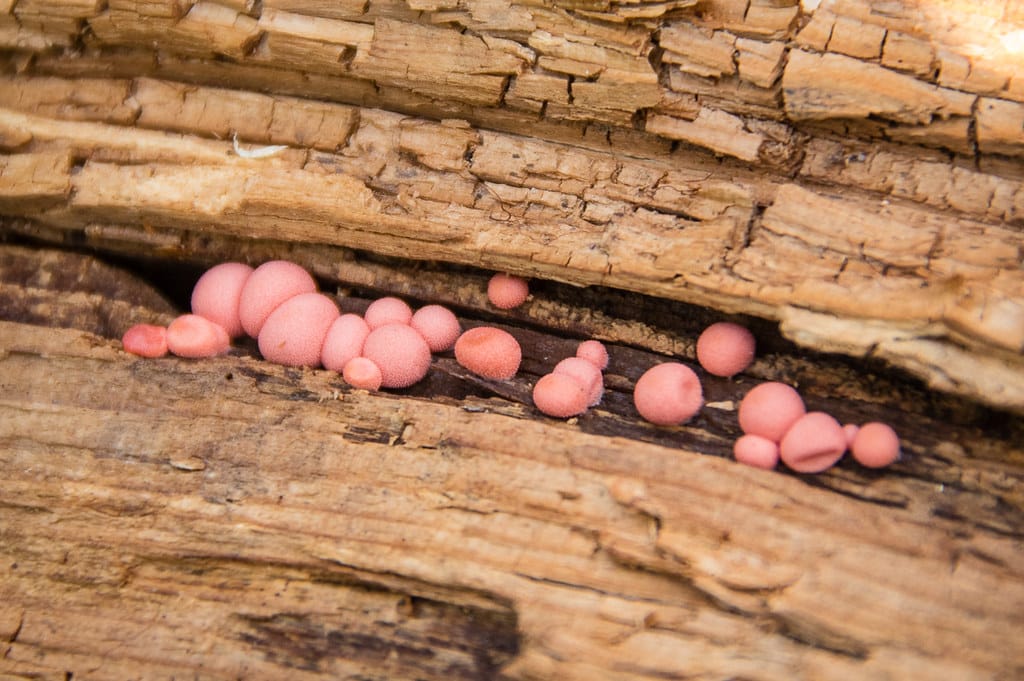Slime moulds look a bit like fungi and resemble them by using spores to reproduce, but like animals they need to forage for their food. They come in all colours, shapes, and sizes as their names indicate: tapioca, dog vomit, wolf’s milk, and chocolate tube.
Slime moulds live in damp, shady habitats and can often be found on rotting wood or logs where they contribute to the decomposition of dead vegetation. There are two types of slime moulds.
1. Cellular slime moulds stay as a single cell throughout their entire life cycle and are invisible to the naked eye. They can, however, act in unison when hunting for food: “When an individual cell encounters a food source, it sends out a chemical signal which attracts others of its kind, drawing them in until they form a mass which is capable of movement in an amoeba-like fashion, with each cell maintaining its individual integrity.”
2. Plasmodial slime moulds start out as single cells but join together in a mass with one cellular membrane while retaining their individual nuclei. These are the slime moulds you’re most likely to see when walking through the woods.
“For part of their life slime mould amoeba live independently as single-celled organisms in the soil (which are far too small to see unless you use a microscope). But when their food (bacteria found in rotting wood and dead plants) is in short supply, or when they want to reproduce, the little organisms mass together in a great slimy pile. They communicate and coordinate their movements by producing chemicals, which change the behaviour of each protozoa by stimulating receptors on their cell membrane – just like the nerve cells in our brain and spinal cord.” [Horniman Museum & Gardens]
Three Common Slime Moulds
Dog vomit slime mould (fuligo septica) is also known as scrambled egg slime or flowers of tan because of its colour. It’s often found on bark mulch in urban gardens after rain and can be found worldwide. It looks like fluffy foam at first but gradually develops a crusty, powdery surface. Underneath is a mass of dark brown spores that are released when the crust is broken.
Wolf’s milk slime mould (lycogala epidendrum) forms small pink or brown cushion-like blobs that are scattered or in groups on rotting wood. The immature fruiting bodies are filled with a pink paste-like fluid (hence the mould’s alternate name of toothpaste slime) that ripens into a powdery mass of tiny grey spores.
Red raspberry slime mould (tubifera ferruginosa) can be found on damp rotting wood throughout Europe and North America. It forms small round fruiting bodies made up of tightly bunched gelatinous rods that are bright red when young and purple-brown when mature.

Cities in Motion
Slime moulds work together as a single entity to forage for food. They do it so effectively that researchers are using them to design a more efficient model for Toronto’s subway system.
“Physarum polycephalum is a slime mould, a single-celled amoeboid organism that grows as a greenish-yellow system of veins. These veins form a tubular network that is optimized to transfer nutrients efficiently throughout the entire organism. Slime moulds first ‘forage’ broadly over an area, then refine their tubular network to optimize for transport of the nutrients. Now, researchers believe the slime mould’s efficient organic structure could provide a model for optimizing other networks – including those designed to move people and goods around a city.” [University of Toronto]
Murder and Mayhem
Slime moulds may also help solve a mystery. Check out The Slime Mold Murders by Ellen King Rice, an ecological thriller set in the woods of the Pacific Northwest.
Photo credit: https://www.flickr.com/photos/apmckinlay/51286795337 and https://www.flickr.com/photos/apmckinlay/14765685640
EcoFriendly West informs and encourages initiatives that support Western Canada’s natural environment through its online publication and the Nature Companion website/app. Like us on Facebook, follow us on Twitter or Mastodon, or subscribe by email.
